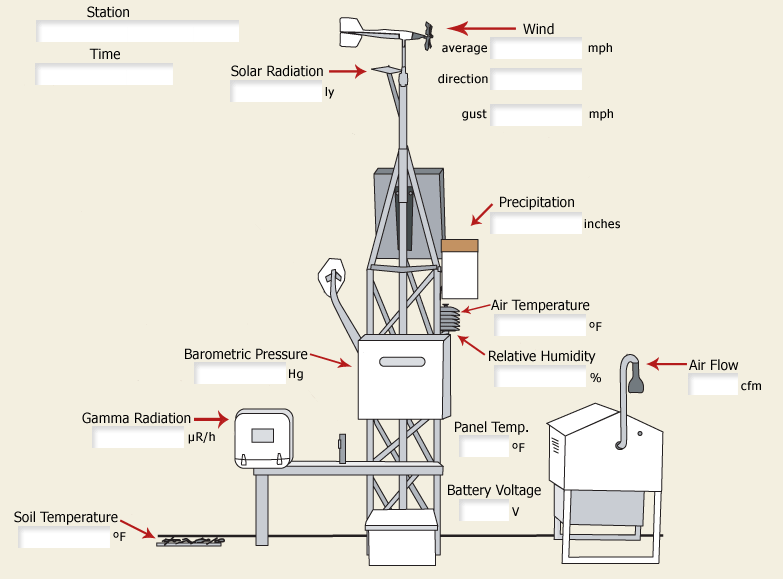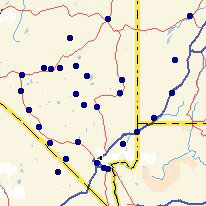Select a station from the map


Observation Information
Observation information can also be seen by placing your mouse cursor over the observation name above.
Air Flow
The average volume of air flow passing through the air filter of the air sampler. Units are in cubic feet per minute.
Air Temperature
The average ambient air temperature during the 10 minute observation period.
Barometric Pressure
The 10 minute average station barometric pressure. Units are inches of mercury. The 3 hour pressure tendency is indicated as follows:
| -- | Rapidly decreasing |
| - | Slowly decreasing |
| blank | Steady |
| + | Slowly increasing |
| ++ | Rapidly increasing |
Battery Voltage
The 10 minute average system battery voltage.
Gamma Radiation
The 10 minute average gamma radiation. Units are in micro-Roentgens per hour (µR/h).
Panel Temperature
The internal temperature of the data logger. Used to assure system operates within expected temperature ranges.
Precipitation
The total measured rainfall during the 10 minute observation period.
Relative Humidity
The average ambient air relative humidity during the 10 minute observation period.
Soil Temperature
The 10 minute average 4 inch depth soil temperature.
Solar Radiation
The 10 minute average of incoming short wave (.4µm - .7µm) solar radiation. Units are in Langleys. Instrument is a Licor LI-200S.
Station
The location of this station.
Time
The time (in local standard time) of this station's last reported data.
Wind Average
The 10 minute average wind speed (in miles per hour). Instrument is a RM Young wind monitor.
Wind Direction
The indicated direction is the 10 minute vector average of the 3 second observations. Wind is blowing from the indicated compass direction.
Wind Gust
The maximum 3 second duration wind speed that occurred during the 10 minute observation period.
Provisional Data Notice
It is the intent of the CEMP to provide to the public accurate, near real-time monitoring data through this web site. However, it should be noted that these data are provisional and therefore may be subject to change. Provisional data may be adjusted for various reasons including disruption of sensors, instrument calibration, equipment failure, and problems with data transfer. These data are not valid until thoroughly reviewed and evaluated by the Desert Research Institute. Data users are cautioned to carefully consider the provisional nature of this information before any application, particularly for decisions that concern personal or public safety or the conduct of business that involves substantial monetary or operational consequences. Information concerning the accuracy and appropriate uses of these provisional data may be obtained by contacting the Western Regional Climate Center at wrcc@dri.edu or by calling (775) 674-7010.
